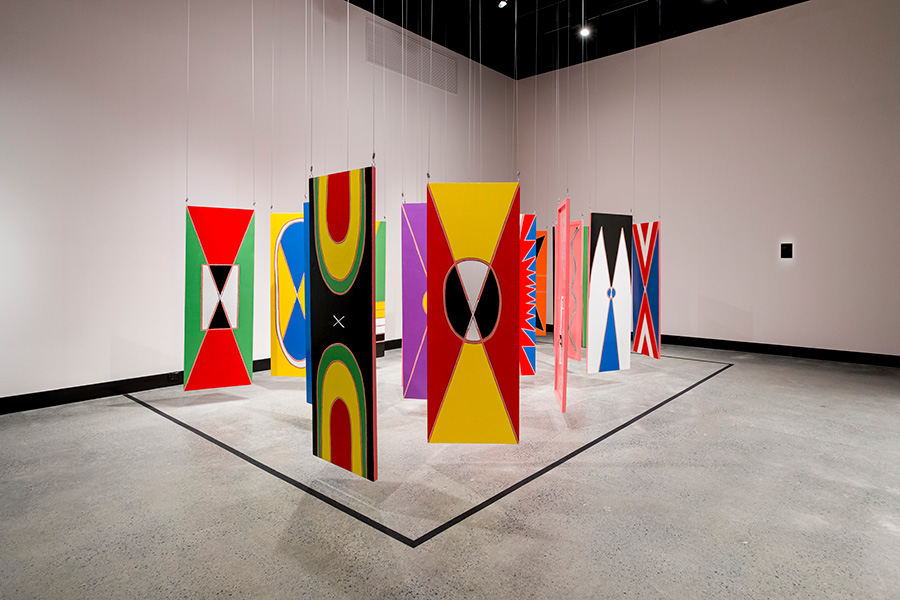Bridging contemporary art and ancestral knowledge systems, Yuriyal Bridgeman’s multidisciplinary practice has already made a significant contribution to the post-colonial Australian landscape.
— Patrice Sharkey
Image: Yuriyal Bridgeman, 'a barrow, a singsing', 2022, installation view. Photograph by Charlie Hillhouse. Image courtesy HOTA Gallery.
Yuriyal Bridgeman (PNG/QLD)
Bridging contemporary art and ancestral knowledge systems, Yuriyal Bridgeman’s multidisciplinary practice has already made a significant contribution to the post-colonial Australian landscape. As noted in a review of his 2024 mid-career survey at Griffith University Art Museum, “Over the past decade, the artist has established himself as a force to be reckoned with.”[1]
Born in Redcliffe, Queensland, to a Papua New Guinean mother and an Anglo-Australian father, Bridgeman grounds his practice in his dual heritage and deep ties to his maternal people, the Yuri tribe of the southern Simbu Province. His work reflects a sustained engagement with representation, belonging, and the evolving role of cultural tradition within contemporary life.
Bridgeman’s early works, produced after graduating from the Queensland College of Art in 2007, employ performance and portraiture to interrogate how bodies are disciplined, adorned and displayed. Through staged tableaux—at once humorous and disquieting—he exposes the social and cultural mechanisms through which identity is constructed and consumed. A key work from this period, Wilma Jr. (‘Blacky’) (2009), originally photographed for his series The Sport and Fair Play of Aussie Rules (2008–10), presents a three-dimensional fibreglass cast of the artist’s friend in a classical pose, imbued with the bravado of the athlete as specimen. Positioned like a museum diorama, the figure is surrounded by “tribal” attributes, glitzy trophies, fast food and cheap souvenirs: honoured yet objectified. Like other works from the series, Wilma Jr. (‘Blacky’) both plays with and critiques blackface and primitivist stereotypes while unpacking constructions of masculinity and the complex dynamics of identity’s display across audiences, institutions and social arenas.[2]
Over subsequent years, Bridgeman’s practice has expanded toward community and cultural continuity. Returning regularly to the Highlands of Papua New Guinea, he established Haus Yuriyal in 2015—a collective and creative hub formed with members of his extended family and local community. Functioning as both artist and facilitator, Bridgeman has cultivated Haus Yuriyal as a model of contemporary art-making grounded in traditional systems of collective care and knowledge-sharing. Ten years on, the collective’s projects—spanning shield painting, weaving, performance and film—have been presented in major exhibitions including the 22nd Biennale of Sydney (2020) and the 11th Asia Pacific Triennial of Contemporary Art (QAGOMA, 2024–25).
Prior to colonisation, tribes across the Waghi region of the PNG Highlands crafted shields (kuman) adorned with bold, optically charged geometric motifs—objects that serve as both protection and proclamation. These visual systems form the foundation of Bridgeman’s distinctive aesthetic, with the kuman reimagined as both painting and portrait. A key example is Sikiram / Büng / Scrum (2019), a large-scale wall-based installation for The National 2019: New Australian Art, in which rhythmic geometry across a series of enamel and acrylic painted panels evokes the collective energy and physical choreography of the rugby scrum.
Indeed, rugby league also holds a central place in Bridgeman’s conceptual universe. As he explains, “There is a strong parallel that exists between rugby league, tribal warfare and peace building—particularly in artistic design, choreography and patterning—which is of great interest to me.”[3]
Most recently, Bridgeman participated in Returning Home (Port Moresby, 2025), an artist-led exhibition presented on the occasion of Papua New Guinea’s 50th Anniversary of Independence. Working alongside other diaspora artists of Papua New Guinean heritage, the project sought to honour the past, ground the present and inspire the future. Strategically, it also functioned as an act of political advocacy and role-modelling for local cultural spaces beyond state institutions. A fitting milestone for his ongoing trajectory, Returning Home affirms Bridgeman’s commitment to contemporary art as a living practice of resistance and renewal.
[1] Pamela See, ‘Exhibition review: Yuriyal Bridgeman: yubilong(mi)bilongyu, Griffith University Art Museum’, Artshub, 26 November 2024: https://www.artshub.com.au/news/reviews/exhibition-review-yuriyal-bridgeman-yubilongmibilongyu-griffith-university-art-museum-2763177/ [accessed 14 October 2025].
[2] Sana Balai and Angela Goddard, ‘Yuriyal Bridgeman: Building Trust, Translation, Community, and Yalkuna’ in Yuriyal Bridgeman: yubilong(mi)bilongyu, exhibition catalogue, Griffith University Art Museum, Brisbane, 2024, p.27.
[3] Yuriyal Bridgeman, quoted in, Tristen Harwood, ‘Yuriyal Eric Bridgeman’s language of the shield’, Art Guide, 19 October 2022: https://artguide.com.au/yuriyal-eric-bridgemans-language-of-the-shield/ [accessed 14 October 2025].
Essay written by Patrice Sharkey, October 2025.
Patrice Sharkey is an independent curator and writer who lives on Wurundjeri Land in Naarm/Melbourne.

